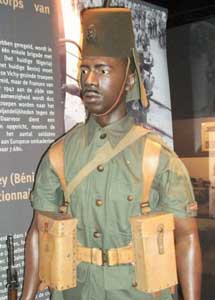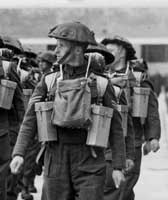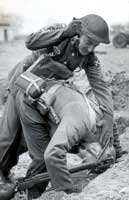Pattern 1939 Leather Infantry Equipment
(An ascribed nomenclature)
 This is the account, such as it can be, of a Pattern that the Army seemed to short-change on the nomenclature front. Two inverted military forms are known, with a third in a civilian publication. In that its Great War counterpart was Pattern 1914 Leather Infantry Equipment, KW has created the nomenclature above.
This is the account, such as it can be, of a Pattern that the Army seemed to short-change on the nomenclature front. Two inverted military forms are known, with a third in a civilian publication. In that its Great War counterpart was Pattern 1914 Leather Infantry Equipment, KW has created the nomenclature above.
Alone of the European Nations, Britain had a volunteer army, which was not reliant on conscription. The Great War was the first conflict in which conscription was authorised by Act of Parliament. After the Armistice, the British Army reverted to its volunteer status, along with volunteers in the Territorial Force, which was reconstituted in February 1920 and re-named the Territorial Army in October 1920. Many Line Battalions were amalgamated and reduced in size, along with T.A. battalions. The war to end all wars required financial retrenchment, there was now less need for a large army and there was probably little stomach for one either.
 The threat of war with Germany was recognised with the passing of the Military Training Act in April 1939. This required all men, aged 20-21 to register and to undergo six months’ military training. At this time, the British Army was around 200,000 strong. On 3rd September, 1939, war was declared and on that day the National Service (Armed Forces) Act was passed by Parliament. This superseded the Military Training Act and required all males of 18 to 41 to register, conscription having been re-introduced by the Act. At the outbreak of war, the British Army had just under 900,000 men, inclusive of the T.A., In March 1939, the T.A. had been authorised to almost treble their strength, from 130,000 to 340,000, of whom 100,000 would go to Anti-Aircraft Command. The official photograph at right shows members of the Auxiliary Military Pioneer Corps, an organisation of men of age between 30 and 50 who were employed for domestic duties in order to free up army troops for service overseas. From the Edward Hallett Collection, © Edward Hallett 2017.
The threat of war with Germany was recognised with the passing of the Military Training Act in April 1939. This required all men, aged 20-21 to register and to undergo six months’ military training. At this time, the British Army was around 200,000 strong. On 3rd September, 1939, war was declared and on that day the National Service (Armed Forces) Act was passed by Parliament. This superseded the Military Training Act and required all males of 18 to 41 to register, conscription having been re-introduced by the Act. At the outbreak of war, the British Army had just under 900,000 men, inclusive of the T.A., In March 1939, the T.A. had been authorised to almost treble their strength, from 130,000 to 340,000, of whom 100,000 would go to Anti-Aircraft Command. The official photograph at right shows members of the Auxiliary Military Pioneer Corps, an organisation of men of age between 30 and 50 who were employed for domestic duties in order to free up army troops for service overseas. From the Edward Hallett Collection, © Edward Hallett 2017.
In parallel with this, the Emergency Powers (Defence Act) of August 1938 was used to call up Army reservists, together with volunteers for Air Raid Precautions - Civil Defence - as they would become. The T.A., R.A.F. Volunteer Reserve and A.R.P. gained around half a million volunteers. The net result of this was the Army increasing to 2,000,000 men. All very fine, but it was the same problem that was faced in 1914, consequent on the raising of Kitchener’s New Armies and, thereafter, conscription. The logistics of clothing, equipping and arming this hugely increased force then became apparent.
 Just as had happened in 1914, emergency measures were required. The heads of the leather industry were approached and asked to design a leather alternative to Patt. ’37. This was then delegated to two men, sadly un-honoured by history. Over one weekend, they designed and made-up a set. This was taken to the War Office, where it was approved on the spot – in one day! An order for one million sets of Leather Infantry Equipment Pattern 1939 was passed back to the leather manufacturers. By the end of 1939, this order had almost been filled. As indicated by the dates as late as 1942 in surviving artefacts, further orders must then have followed. The photo at left, from the Edward Hallett Collection, shows soldiers in training, wearing Patt. '39 L.I.E.
Just as had happened in 1914, emergency measures were required. The heads of the leather industry were approached and asked to design a leather alternative to Patt. ’37. This was then delegated to two men, sadly un-honoured by history. Over one weekend, they designed and made-up a set. This was taken to the War Office, where it was approved on the spot – in one day! An order for one million sets of Leather Infantry Equipment Pattern 1939 was passed back to the leather manufacturers. By the end of 1939, this order had almost been filled. As indicated by the dates as late as 1942 in surviving artefacts, further orders must then have followed. The photo at left, from the Edward Hallett Collection, shows soldiers in training, wearing Patt. '39 L.I.E.
Infantry Equipment, Pattern 1914 had been intended for training use only, but as is clearly evident, it found its way onto the Western Front and to Palestine. The same cannot be said of Patt. ’39, which does appear to have been deployed for training purposes only. A document in the Nick Wall Collection sheds some additional light, being a unit order for the 202nd Light Bty A.A., R.A. and two photographs depict Pattern 1939 in Battle Order. Certainly it would have been an upgrade, as the Royal Artillery were then using the Haversack, Other Services and a water bottle in the Carrier, Other Services.
A.C.I. 2339/1941 gives the wider picture, stating in Table B that the Patt. ’39 tool and its Carrier would henceforth be issued to:-
Non-Field Force Units
Home Defence Battalions
Young Soldier Battalions
Garrison Battalions
Infantry Training Centres
Machine Gun Training Centres
O.C.T.U., Infantry (Officer Cadet Training Unit)
O.C.T.U., Sandhurst

 The two illustrations at left, were painted from photographs, by Malcolm McGregor and are included in The Armed Forces of World War II. Uniforms, insignia and organisation by Andrew Mollo (Orbis Publishing, 1981). These show a native soldier, in the Belgian Congo, in Field Service Marching Order and a Polish soldier in Skeleton Order, with Cartridge Carriers. Post-war, the Belgian and Dutch Armies continued to wear the Pattern in Europe. The photograph at the beginning of this article is from the Belgian War Museum, and also shows a Congolese soldier in Patt. '39 (although he's wearing a Patt. '37 Belt). It was supplier to KW by Guy Bud of the WWII Re-enacting Forum. We would welcome details of any other countries using the Pattern, effectively after its Sell-by-date.
The two illustrations at left, were painted from photographs, by Malcolm McGregor and are included in The Armed Forces of World War II. Uniforms, insignia and organisation by Andrew Mollo (Orbis Publishing, 1981). These show a native soldier, in the Belgian Congo, in Field Service Marching Order and a Polish soldier in Skeleton Order, with Cartridge Carriers. Post-war, the Belgian and Dutch Armies continued to wear the Pattern in Europe. The photograph at the beginning of this article is from the Belgian War Museum, and also shows a Congolese soldier in Patt. '39 (although he's wearing a Patt. '37 Belt). It was supplier to KW by Guy Bud of the WWII Re-enacting Forum. We would welcome details of any other countries using the Pattern, effectively after its Sell-by-date.
The huge stocks of Patt. ’08 W.E., left over from the Great War, meant that the Territorial Force could be universally equipped with a modern Pattern. Patt. ’37 W.E. had been introduced, consequent on adopting the Bren Gun, which was also to form the equipment of the T.A. Rather than have to abandon their older webbing, it was instead upgraded with Basic pouches and a larger Haversack, bringing it to the same carrying capability as Patt. ’37 W.E. Even so, many T.A. in the B.E.F. went to France with Patt. ’08 W.E. With the evacuation at Dunkirk, much equipment had been lost, including accoutrements. Mills were able to immediately supply 30,000 sets of Patt. ’08, from their stocks and a policy of conserving complete sets. This was not enough and the combined efforts of the Mills Equipment Company and M. Wright and Sons could not begin to manufacture Patt. ’37 on the scale required. Pattern 1939 therefore played an extended role in being used for training, thus releasing Patt. ’08 and ’37 for use by front-line troops. Manufacture has been noted, as late as 1942.
Rog Dennis, December, 2010